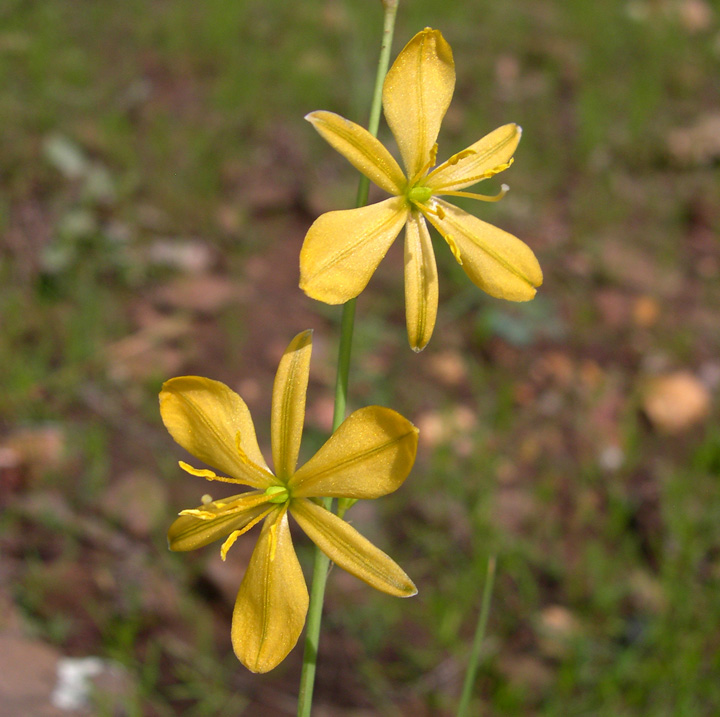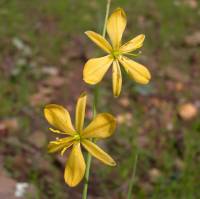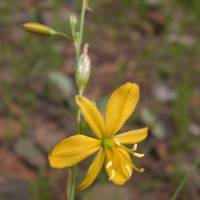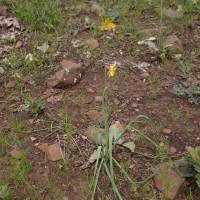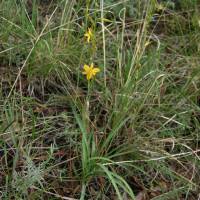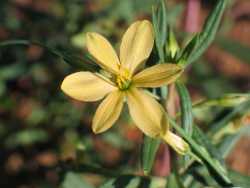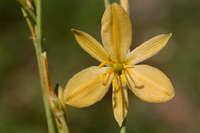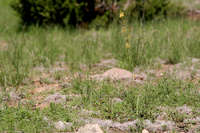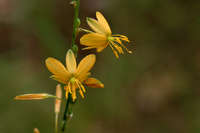Storage roots enlarged 1-2(-4) cm from corms, (1.5-)2-5 cm. Leaves: basal 3-15, 8-40 cm × 0.5-9 mm, blade very narrowly linear to narrowly linear, margins denticulate, ciliate; cauline 0-3, (0.5-)1-9(-13) cm, blade long-acuminate in most specimens, the proximal not exceeding next node. Inflorescences 1-2, 0-1(-3)-branched, 20-60(-84) cm, wholly glabrous or scabrescent toward base. Flowers facing upward or away from scape; tepals elliptic, (7.5-)9-15 mm, outer 2-4 mm wide, inner 4-8.5 mm wide; filaments inserted in open pits, narrowly cylindric to narrowly clavate, 4-8.5 mm; anthers distinct, versatile, 1.5-3.5 mm; ovary 2-5 mm. Capsules broadly oblong to oblong, 7-16 × 3-6 mm. 2n = 16, 32, 48.
Flowering (late May--) mid Jul--early Oct. Desert grasslands, pinyon-juniper woodlands, juniper-oak-pine woodlands, openings in yellow-pine and pine-fir-spruce forests; 1500--2900 m; Ariz., N.Mex., Tex.; Mexico.
Echeandia flavescens is a highly variable polyploid complex. Most specimens from the flora fall into one of three groups: slender plants with leaves 1-4 mm wide and capsules 7-11 mm; slender plants with leaves 1-4 mm wide and capsules 12-15 mm; and more robust plants with leaves 4-9 mm wide and capsules 12-16 mm. The first plants are diploids and the last two are hexaploids and octoploids, respectively. The robust morph was described as Anthericum stenocarpum and has been collected at scattered locations throughout the distributional range of the species. Because the correlation between morphology and ploidy level breaks down across the distributional range, no infraspecific taxa are recognized.
Duration: Perennial
Nativity: Native
Lifeform: Forb/Herb
General: Perennial scapose herbs, 15-40 cm tall; from corms, 2-5 cm, with enlarged storage roots, 1-2 cm.
Leaves: Basal and cauline; basal leaves 3-15 per plant, with very narrowly linear blades, 8-40 cm long by 1-9 mm wide, the margins denticulate and ciliate; cauline leaves 0-3 per stem, 1-9 cm long, the blades long-acuminate in most specimens.
Flowers: Yellow, in 1-2 slender racemes per plant; flowers face upward or away from scape; tepals elliptic, 9-15 mm long, outer tepals 2-4 mm wide, inner tepals 4-8 mm wide, yellow with a darker midvein; filaments inserted in open pits, narrowly cylindric to narrowly clavate, 4-8 mm.
Fruits: Capsules oblong, 1-1.5 cm long, splitting open to release seeds when mature.
Ecology: Found in grasslands, woodlands, and openings in pine forests, from 5,000-9,000 ft (1524-2743 m); flowers May-October.
Distribution: AZ, NM, sw TX; south to s MEX.
Notes: A distinct monocot with flowers possessing six yellow petals (tepals) arranged vertically on an erect, leafless flowering stalk; fruits which are oblong capsules often surrounded by the dried, clearish tepals; and tufts of grasslike basal leaves that are fringed with hairs on edges.
Ethnobotany: Taken to help ease delivery of the placenta and as veterinary aid.
Etymology: Echeandia is named for Jose Maria de Echeandia (died 1871), a Mexican engineer and politician, while flavescens means becoming yellow.
Synonyms: Anthericum flavescens, Anthericum torreyi
Editor: SBuckley 2010, FSCoburn 2014, AHazelton 2015


